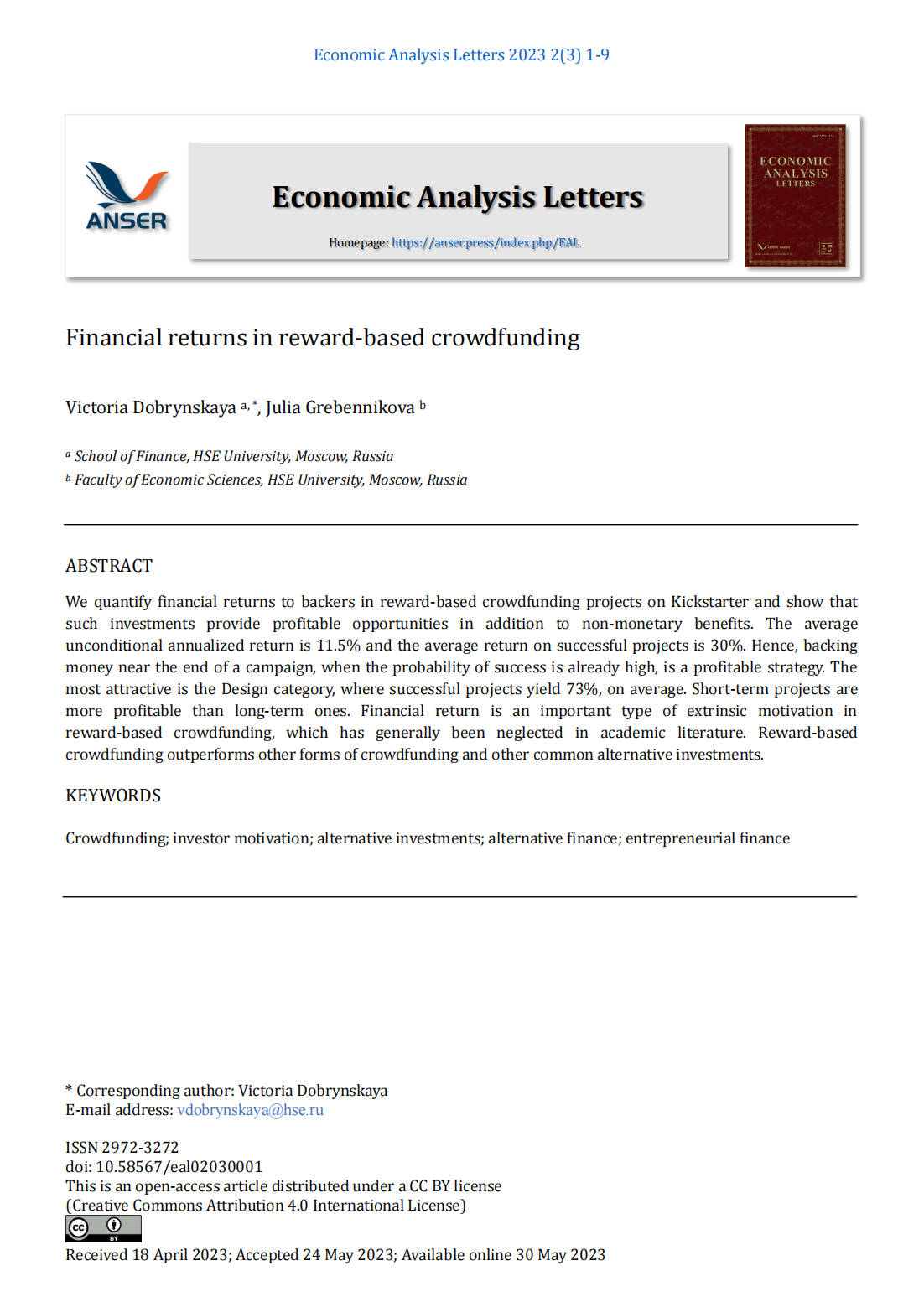Financial returns in reward-based crowdfunding
DOI:
https://doi.org/10.58567/eal02030001Abstract
We quantify financial returns to backers in reward-based crowdfunding projects on Kickstarter and show that such investments provide profitable opportunities in addition to non-monetary benefits. The average unconditional annualized return is 11.5% and the average return on successful projects is 30%. Hence, backing money near the end of a campaign, when the probability of success is already high, is a profitable strategy. The most attractive is the Design category, where successful projects yield 73%, on average. Short-term projects are more profitable than long-term ones. Financial return is an important type of extrinsic motivation in reward-based crowdfunding, which has generally been neglected in academic literature. Reward-based crowdfunding outperforms other forms of crowdfunding and other common alternative investments.
References
Adhami, S., G. Gianfrate, and S. Johan (2019). Risks and returns in crowdlending. SSRN working paper available at https://ssrn.com/abstract=3345874.
Agrawal, A., Catalini, C., and A. Goldfarb (2014). Some simple economics of crowdfunding. Innovation Policy and the Economy, 14(1), 63-97, https://www.nber.org/papers/w19133.
Andreoni, J. (1990). Impure altruism and donations to public goods: A theory of warm-glow giving. The Economic Journal, 100, 464–477, https://doi.org/10.2307/2234133.
Belleflamme, P., T. Lambert, and A. Schwienbacher (2014) Crowdfunding: Tapping the right crowd. Journal of Business Venturing 29(5), 585-609, https://doi.org/10.1016/j.jbusvent.2013.07.003.
Bretschneider, U., K. Knaub, and E. Wieck (2014) Motivations for crowdfunding: What drives the crowd to invest in start-ups? Proceedings of the European Conference on Information Systems 2014, http://pubs.wi-kassel.de/wp-content/uploads/2015/04/JML_5321.pdf.
Cholakova, M. and B. Clarysse (2015). Does the possibility to make equity investments in crowdfunding projects crowd out reward-based investments? Entrepreneurial Theory and Practice, 39(1), 145-172, https://doi.org/10.1111/etap.12139.
Collins, L. and Pierrakis, Y. (2012). The venture crowd: Crowdfunding equity investment into business. London: NESTA. Available at http://www.nesta.org.uk/publications/venture-crowd.
Daskalakis, N. and W. Yue (2017). User’s perceptions of motivations and risks in crowdfunding with financial returns. SSRN working paper available at: https://ssrn.com/abstract=2968912.
De Buysere, K., Gajda, O., Kleverlaan, R., & Marom, D. (2012). A framework for European crowdfunding. Available at http://www.crowdfundingframework.eu.
Dimson, E., Rousseau, P.L., Spaenjers, C. (2015). The price of wine. Journal of Financial Economics, 118(2), 431–449, https://doi.org/10.1016/j.jfineco.2015.08.005.
Dimson, E., Spaenjers, C. (2011). Ex post: The investment performance of collectible stamps. Journal of Financial Economics 100 (2), 443–458, https://doi.org/10.1016/j.jfineco.2010.12.005.
Dobrynskaya, V., Kishilova, J. (2022). LEGO: The toy of smart investors. Research in International Business and Finance 59, 101539, https://doi.org/10.1016/j.ribaf.2021.101539.
Gerber, E.M., Hui, J.S., & Kuo, P.Y. (2012). Crowdfunding: Why people are motivated to post and fund projects on crowdfunding platforms. Northwestern University working paper, https://www.researchgate.net/publication/261359489_Crowdfunding_Why_People_are_Motivated_to_Post_and_Fund_Projects_on_Crowdfunding_Platforms.
Harmeet, K., and J. Gera (2017). Effect of social media connectivity on success of crowdfunding campaigns. Procedia Computer Science, 122: 767-774, https://doi.org/10.1016/j.procs.2017.11.435.
Levin, F. (2015). Success determinants of crowdfunding projects. Review of Business and Economic Studies, 3(4): 79-87, https://ideas.repec.org/a/scn/00rbes/y2015i4p79-87.html.
Mollick, E. (2014). The dynamics of crowdfunding: An exploratory study. Journal of Business Venturing, 29, 1–16, https://doi.org/10.1016/j.jbusvent.2013.06.005.
Muniz, A.M.Jr. and O’Guinn, T.C. (2001). Brand community. Journal of Consumer Research, 27, 412–432, https://doi.org/10.1086/319618.
Renneboog, L., Spaenjers, C. (2012). Hard assets: The returns on rare diamonds and gems. Finance Research Letters 9(4), 220–230, https://doi.org/10.1016/j.frl.2012.07.003.
Renneboog, L., Spaenjers, C. (2013). Buying beauty: On prices and returns in the art market. Management Science 59, 36–53, https://www.jstor.org/stable/23359604.
Ryan, R.M., and E.L. Deci (2000). Intrinsic and extrinsic motivations: Classic definitions and new directions. Contemporary Educational Psychology, 25(1), 54-67, https://doi.org/10.1006/ceps.1999.1020.
Ryu, S., J. Park, K. Kim, and W.-G. Kim (2020). Reward versus altruistic motivations in reward-based crowdfunding. International Journal of Electronic Commerce, 24(2), 159-183, https://doi.org/10.1080/10864415.2020.1715531.
Schwienbacher, A., and B. Larralde (2010). Crowdfunding of small entrepreneurial ventures. Handbook of Entrepreneurial Finance, Oxford University Press, September 28th, 2010, http://dx.doi.org/10.2139/ssrn.1699183.
Signori, A., and S. Vismara (2016). Returns on investments in equity crowdfunding. Available at SSRN: https://ssrn.com/abstract=2765488.
Vismara, S. (2016). Equity retention and social network theory in equity crowdfunding. Small Business Economics. https://doi.org/10.1007/s11187-016-9710-4.
Zheng, H., D. Li, J. Wu, and Y. Xu (2014). The role of multidimensional social capital in crowdfunding: A comparative study in China and US. Information & Management, 51(4): 488-496, https://doi.org/10.1016/j.im.2014.03.003.

Downloads
Published
How to Cite
Issue
Section
License
Copyright (c) 2023 Victoria Dobrynskaya, Julia Grebennikova

This work is licensed under a Creative Commons Attribution 4.0 International License.